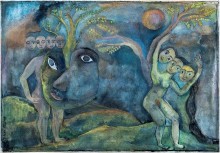Exhibition: The Goddess, the Deity & the Cyborg
This group exhibition explores how artists have conjured, revered and reimagined the goddess figure. Drawing from the works in The Women’s Art Collection as well as loans from public and private collections, the exhibition explores the enduring appeal of the goddess and traces how artists have adapted and even transformed the goddess into an ambiguous figure undefined by gender or even bodily form.
Dating from the 1970s to the present day, the curated works include the voices of contemporary artists who present alternative versions of the goddess figure, including non-Western perspectives and ones that complicate accepted notions of the body.
Goddess feminism originated in America in the 1970s. Two of its pioneers are represented in this exhibition. American artist Mary Beth Edelson engaged with the figure of the prehistoric Goddess through photomontages and performances, during which the artist summoned an ancient goddess lost to historical record. Climate activist and eco-feminist Monica Sjöö was a leading member of the goddess movement in the UK. Her painting Earth is Our Mother (1984) includes the symbol of the goddess to suggest the connectedness between women’s cycle of menstruation, birth and menopause and the life and death cycles of the universe.
Contemporary artists represented within the exhibition search for a figure undefined by gender or bodily form. The seductive paintings of Alicia Reyes McNamara depict the non-binary deity Tlazoltéotl, an Aztec goddess who was originally an earth mother goddess associated with fertility, sexuality, the earth, waste and dirt.
The work of Wangechi Mutu revises and reimagines goddess representations. Mutu creates multi-layered collages and prints that explore mythology, sexuality, femininity and politics, often summoning alternative futures. The Original Nine Daughters (2012) series depicts hybrid creatures that are part-human part-animal. In doing so, Mutu uproots the figure of the goddess from something embodied – and, by association, gendered – to something otherworldly and liminal, unbound by place and landscape.
This hybridity and engagement with technology connects with the feminist post-humanist writing of Donna Haraway. In her 1985 essay ‘A Cyborg Manifesto’, Haraway rejects the so-called ‘goddess movement’ of the 1970s and 80s. She complicates the rigid boundaries that separate human from animal and human from machine, instead declaring: “I would rather be a cyborg than a goddess”.
Inspired by the Roman water deity Senuna, whose hoard was recently excavated at nearby Ashwell, and commissioned especially for this show, Candida Powell Williams’ new sculpture brings together votive iconography, a hydropower temple and an interlocking back bone. At its centre is a mirror that invites the viewer into the work both physically and symbolically to engage with its overlapping narratives on the cultural and imagined evolution of this long forgotten but almighty figure.
The exhibition is curated by Harriet Loffler Curator at The Women’s Art Collection with guidance by Juliet Wimhurst and curatorial support by Ella Nixon and Elisabetta Garletti.
Artists
Mary Beth Edelson, Roberta Booth, Lubaina Himid, Alison Hunte, Maggi Hambling, Jill Lewin, Linder, Jacqueline Morreau, Wangechi Mutu, Alicia Reyes McNamara, Candida Powell Williams, Gurminder Sikand, Monica Sjöö, Juliet Wimhurst.
The exhibition is generously supported by the Wimhurst Muller Trust.
Public Programme & Publication
This exhibition will be accompanied by a series of events including a curated programme by The Women’s Art Collection at Fitzwilliam Museum. These events will feature writers, artists and academics to connect ‘The Goddess, the Deity and the Cyborg’ with the Fitzwilliam’s exhibition of visionary artist William Blake.
A fully illustrated publication will be available in April with contributions by curator Harriet Loffler, poet and academic Bhanu Kapil and art historian Catherine McCormack.
Image: Gurminder Sikand Tree Spirits 1991 © The Gurminder Sikand Estate
